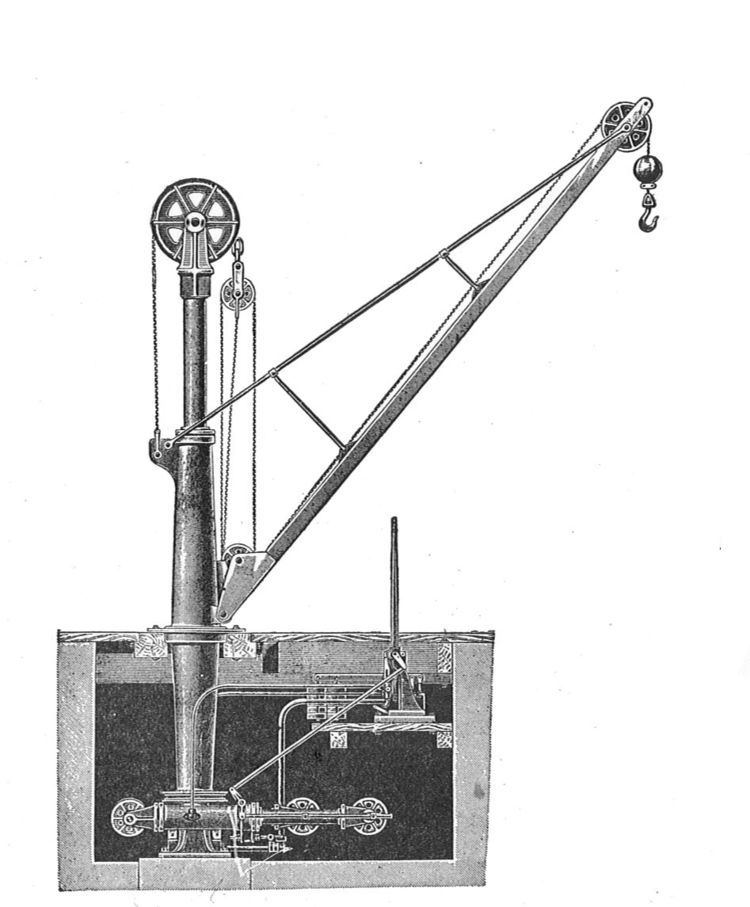 | ||
A hydraulic jigger is a hydraulically powered mechanical winch.
Contents
From the mid-19th century, hydraulic power became available throughout the increasingly modern dockyards and warehouses. This was generated centrally and distributed by pipework, either around a dock estate, or across a city by the new hydraulic power networks.
The jigger was developed by William Armstrong, around 1840, as part of his hydraulic crane The hydraulic crane was the invention that first made his fortune and established the engineering and armaments firm of Armstrongs of Elswick.
Operation
The jigger was one of the first hydraulic machines of the Victorian age, after Bramah's hydraulic ram but before the continuously-rotating hydraulic motor. It allowed the mechanism of the ram to be used to move over a usefully long distance, not merely the length of the ram.
A jigger works like a pulley block, but in reverse. Rather than turning an easy pull on a rope into a powerful lift, the jigger uses the powerful force of a hydraulic ram, but limited in how far it can travel, to pull a long length of chain. The chain is looped several times lengthwise around the ram cylinder, running over a number of pulleys at each end. When the cylinder moves, the pull on the end of the chain is multiplied by the number of loops. The force of the jigger's pull is reduced similarly, according to how many times the chain was looped. As the cylinder had adequate power to begin with, and could simply be made larger in diameter when needed, this was not a significant limit on the jigger's force.
Unlike cylinders, jiggers always provided a tension pull, rather than a compressive push.
The first jiggers pre-dated the development of flexible steel wire rope and so they used wrought iron chain, rather than the natural fibre rope otherwise available. Later machines did switch to wire rope.
Concentric cylinders
Some applications, such as cranes, needed to lift both heavy and light (empty hook) weights. Loaded, heavy, lifts were made by the conventional cylinder, its diameter sized according to the maximum capacity. However even a light load on such a piston would still consume the same quantity of high-pressure water, which was charged for by consumption. To reduce this effect, compound pistons were used: two concentric pistons. When unloaded, the smaller central piston would move first. Only if this was held down by the load, the larger outer piston would also begin to move, lifting both pistons and the full load together.
Applications
The basic jigger mechanism was used very widely, for a range of machines across dockyards, warehouses, railway yards and engineering workshops. They were even to be found in theatres, lifting the stage curtains.
Many dockyards used small portable jiggers mounted on wheeled carriages. These could be moved around the quays as needed, and plumbed into outlets in the hydraulic mains with screwed pipe unions. They were used as portable winches for all manner of tasks. A typical task would be winching bales out of the hold of a ship, up a sloping gangway. Bales of bulk products such as jute or cotton were made too large and heavy for dockers to lift by hand, and the jigger appeared at a time when cranes were still only in limited numbers.
Cranes
The first application of jiggers had been for Armstrong's first hydraulic crane and this remained an important application for them.
A distinctive type of crane was the warehouse wall crane or 'whip'. The ram was mounted vertically on an outside wall with a small jib or fixed pulley above it. The space available by external mounting allowed the use of long cylinders and very long lifts, spanning several floors.
